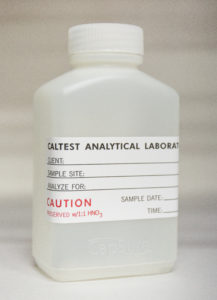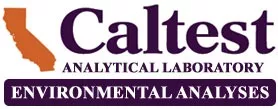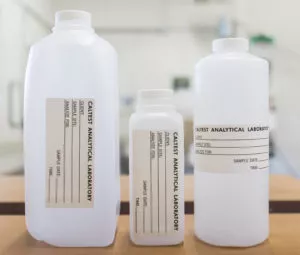Caltest Sampling Guides
We’ve created these sampling guides to provide guidance on proper, method and/or permit-specified sampling protocol. Proper sampling is critically important for a variety of reasons including those noted below. The guides include details you’ll need to collect a variety of types of samples and analyses.
If you have any questions, or if there is a method that isn’t noted, please feel free to contact our client services team to get more information. Call 707/258-4000 or email pmgr@CaltestLabs.com.
If you need sampling containers, request a bottle order using the online request form.
If you need samples picked up, request a pickup using the online form.
Proper sampling techniques, why are they important?
- Minimize/eliminate non-compliance data
- Meet method requirements
- Comply with permit requirements
- Reduce interferences
- Maintain integrity of the sample
Developing a sampling plan to ensure proper sample collection
- What analysis and method do you need?
- What is your matrix (e.g., stormwater, wastewater, drinking water etc.)? Who is your regulator?
- What containers, sample volume, preservation and holding times are noted for the method?
- What else? Need gloves? Need pretreatment (Chlorine or Nitrates?)
- Check the Bottle Preservation and Holding Time Chart.
- What type of sample are you collecting?
- Grab or comp
- Raw water vs distribution
- Do I need any specific QC – e.g., MS/D?
- Field blanks and trip blanks—some permits and/or methods may require field or trip blanks, some may suggest them.
- Location and timing
- Representative sample
- Coordinate with your Caltest Project manager to order supplies arrange for pickups and alert lab of any analyses with short holding times
- Request project-specific COC and review the “Instructions for completing a Chain of Custody form“
Reminder– when in doubt, check your permit or check with your regulator!
After sampling
Deliver or ship samples to the laboratory to ensure that holding times are met. Holding time starts at sample collection and ends at preparation and/or analysis. Be sure to allow time for the laboratory to process the samples. See Shipping Instructions for more specifics on shipping samples to Caltest.
For more information
- For information specific to 40 CFR Part 136.3: https://www.epa.gov/cwa-methods/approved-cwa-chemical-test-methods
- Drinking Water Analytical Methods—EPA https://www.epa.gov/dwanalyticalmethods

Click on a guide below
Caltest Reference Chart: Holding Time, Bottle Type, Preservation
Sample Storage and Shipping Instructions
Sampling Instructions- Bacteriological Analyses
Sampling Instructions- Cyanide Analysis
Sampling Instructions – Containers with Sulfuric Acid (H2SO4)
Sampling Instructions- Containers with Nitric Acid (HNO3) (200.8 metals and Hardness)
Sampling Instructions- General Industrial Stormwater Parameters
Sampling Instructions – Volatile Organic Compounds (EPA 624.1,524.2, and 8260)
Sampling instructions – Trace Mercury, Methyl Mercury and Metals (EPA 1630, 1631 and 1638)
Sampling Instructions – Lead and Copper Rule
Sampling Instructions – Sulfide Analysis
Sampling Instructions – Total Organic Carbon (TOC) Analysis
Other Caltest Forms:
Caltest Chain of Custody (COC) – General

